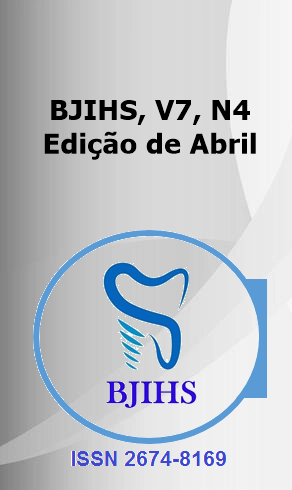Resumo
Introdução: Com as significativas melhorias no campo odontológico, os implantes dentários são tidos como novos modelos de tratamento com resultados promissores. A taxa de sucesso das implantações vem crescendo com o passar dos anos. Por isso, o objetivo desse trabalho é relatar um caso clínico de sucesso na reabilitação de maxila atrófica com implantes dentários. Relato de caso clínico: Paciente MRAC, sexo feminino, 55 anos, feoderma, ASA II, compareceu ao consultório da clínica escola com queixa de dificuldade de mastigação e queixa estética quanto ao sorriso, com histórico de perda dentária há “muitos anos atrás” (sic). Ao exame radiográfico, evidenciou-se reabsorção alveolar em toda a maxila, com remanescente ósseo de qualidade na região anterior, mas com perda de suporte ósseo dos dentes presentes na cavidade oral. Nesse contexto, foi planejado para a paciente uma reabilitação implantossuportada da maxila atrófica, através do planejamento das angulações dos implantes dentários, com o intuito de diminuir a necessidade de outros procedimentos prévios à instalação dos implantes. Foram instalados 6 implantes, com torque mínimo de 30N, para posterior reabilitação protética. Considerações finais: As reabilitações de maxilares atróficos com implantes dentários e próteses do tipo protocolo configuram-se como uma opção terapêutica importante e bastante eficaz quando da necessidade de reestabelecer função e estética em pacientes com necessidade reabilitadora.
Referências
AVILA‐ORTIZ, Gustavo et al. Treatment alternatives for the rehabilitation of the posterior edentulous maxilla. Periodontology 2000, v. 93, n. 1, p. 183-204, 2023.
CHEN, Stephen T.; BUSER, Daniel. Clinical and esthetic outcomes of implants placed in postextraction sites. International journal of oral & maxillofacial implants, v. 24, 2009.
CUCCHI, A., VIGNUDELLI, E., FRANCO, S., GHENSI, P., MALCHIODI, L. and CORINALDESI, G., 2019. Evaluation of crestal bone loss around straight and tilted implants in patients rehabilitated by immediate-loaded full-arch all-on-4 or all-on-6: a prospective study. Journal of Oral Implantology, 45(6), pp.434-443.
HAMEED, M.H. et al. Vertical Ridge Gain with Various Bone AugmentationTechniques: A Systematic Review and Meta-Analysis. Journal of Prosthodontics, v. 28, p. 421-427, 2019.
JENSEN, A.T.; JENSEN, S.T.; WORSAAE, N. Complications related to bone augmentation proceduresof localized defects in the alveolar ridge. A retrospectiveclinical study. Oral and Maxillofacial Surgery, v. 20, n. 2, p. 115-122, 2016.
JÚNIOR, Santiago et al. Manutenção em próteses implantossuportadas: higiene oral. 2013.
KÄYSER, A.F., 1981. Shortened dental arches and oral function. Journal of oral rehabilitation, 8(5), pp.457-462.
KÄYSER, A.F., 1994. Limited treatment goals–shortened dental arches. Periodontology 2000, 4(1), pp.7-14.
KHOURY, F.; HANSER, T. Three-Dimensional Vertical Alveolar Ridge Augmentation in the Posterior Maxilla: A 10-year Clinical Study. The International Journal of Oral & Maxillofacial Implants, v. 34, n. 2, p. 471–480, 2019.
MALÓ P, LOPES A, DE ARAÚJO NOBRE M, FERRO A. Immediate function dental implants inserted with less than 30N·cm of torque in full-arch maxillary rehabilitations using the All-on-4 concept: retrospective study. Int J Oral Maxillofac Surg., v. 47, n. 8, p. 1079-1085, 2018.
NOVAES JR, ARTHUR B. et al. Immediate placement of implants into periodontally infected sites in dogs: a histomorphometric study of bone-implant contact. International Journal of Oral & Maxillofacial Implants, v. 18, n. 3, 2003.
OLIVEIRA, MC.; MIRANDA, MLAO.; RÉGO, MR de S.. Satisfação de pacientes usuários de prótese quanto ao implante em região estética. Pesquisa, Sociedade e Desenvolvimento, [S. l.] , v. 5, pág. e23712541751, 2023.
SÁEZ-ALCAIDE, L.M. et al. Effectiveness of the bone ring techniqueand simultaneous implantplacement forvertical ridge augmentation: a systematicreview. International Journal of Implant Dentistry, v. 6, n. 82, p. 1 – 9, 2020.
SASS, T. et al. Augmentation of the vertical bone defects of the mandible and maxilla with autogenous bone block. Orv Hetil, v. 163, n. 14, p. 558-563, 2022.
TALLARICO, M., MELONI, S.M., CANULLO, L., CANEVA, M. and POLIZZI, G. Five‐year results of a randomized controlled trial comparing patients rehabilitated with immediately loaded maxillary cross‐arch fixed dental prosthesis supported by four or six implants placed using guided surgery. Clinical implant dentistry and related research, v. 18, n. 5, pp. 965-972. 2016.
URBAN, I.A. et al. Effectiveness of vertical ridge augmentation interventions: Asystematic review and meta-analysis. J Clin Periodontol., v. 46, n. 21, p. 319-339, 2019.
URBAN, I.A. et al. Techniques on vertical ridge augmentation: Indications andeffectiveness. Periodontology 2000, v. 00, p. 1-30, 2023.
VAN DER WEIJDEN, F.; DELL’ACQUA, F.; SLOT, D.E. Alveolar bone dimensional changes of post-extraction sockets in humans: a systematic review. J Clin Periodontol., v. 36, n. 12, p. 1048-1058, 2009.
WANG, REN E.; LANG, NIKLAUS P. Ridge preservation after tooth extraction. Clinical oral implants research, v. 23, p. 147-156, 2012.
ZAHWY, M.E. et al. Assessment of vertical ridge augmentation and marginal bone loss using autogenous onlay vs inlay grafting techniques with simultaneous implant placement in the anterior maxillary esthetic zone: A randomized clinical trial.Clinical Implant Dentistry and Related Research, p. 1-8, 2019.

Este trabalho está licenciado sob uma licença Creative Commons Attribution 4.0 International License.
Copyright (c) 2025 Gustavo Renan da Silva Mineiro, Mykelson Hirley Almeida Santos Araújo, Victor Hugo Loureiro Sousa Dantas, Italo Stanley da Silva Nascimento, Luis Felipe de Sousa Andrade, Pedro Leonardo de Sousa Silva, Francisco Jean Seles Oliveira , Victor da Silva Reis, Thálison Ramon de Moura Batista
